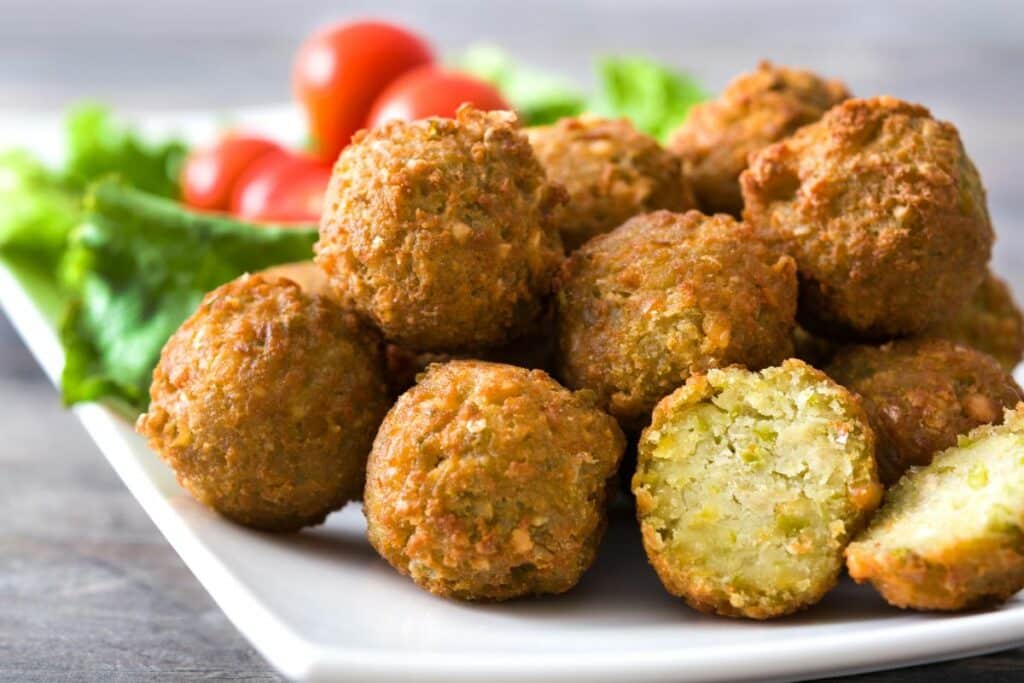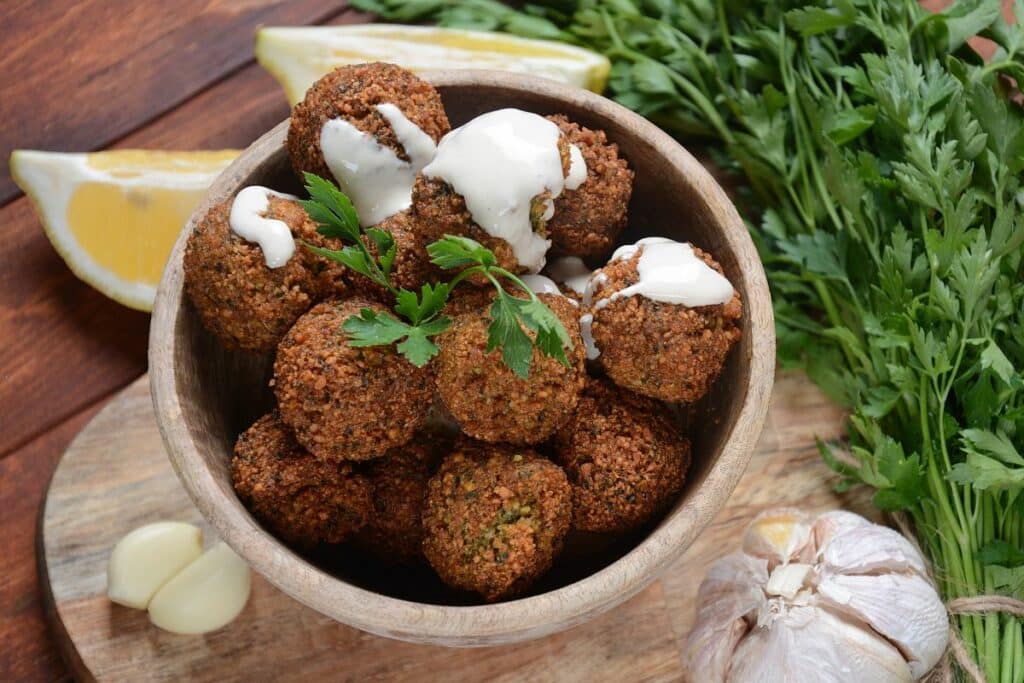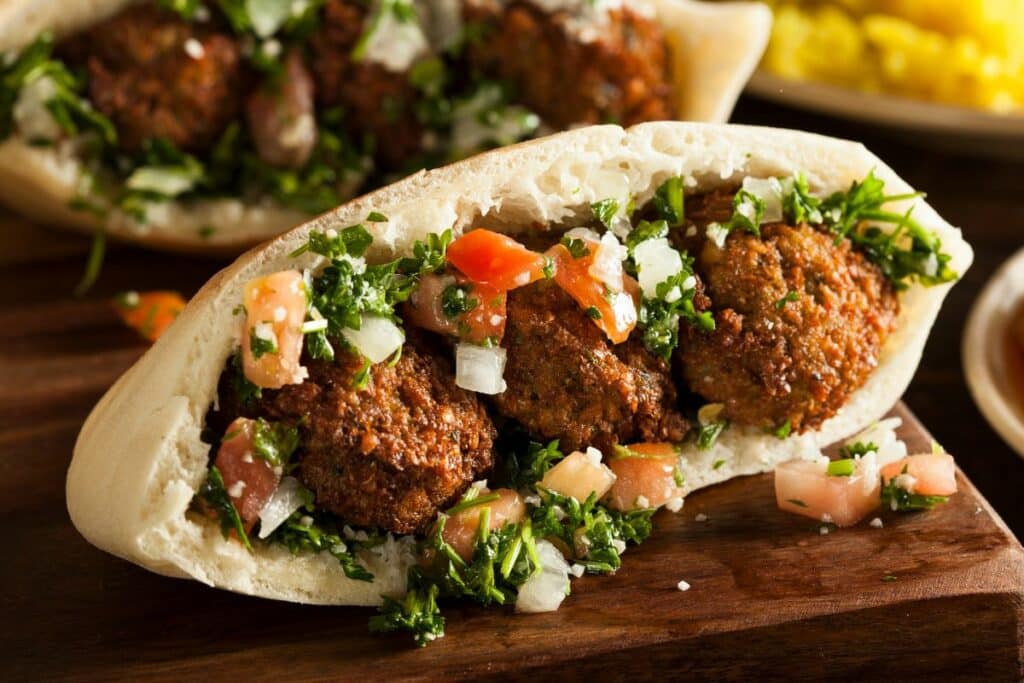For those who have yet to experience the traditional Middle Eastern dish called falafel the flavor might seem mysterious.
However, with its savory blend of spices, fresh herbs, and crunchy texture, falafel is a delicious treat that’s sure to satisfy even the pickiest eaters.

In this article, we’ll explore what makes up the unique taste of falafel and how it can be enjoyed as part of both traditional meals and modern dishes.
History Of Falafel
The origin of falafel is unclear but the dish is a popular street food in many Arab countries, and it has become increasingly popular in Europe and the United States in recent years.
The history of falafel as a modern dish dates back to the 19th century when it became popular in Egypt and the Levant.
It is thought to have been brought to the region from India or Ethiopia. The dish was quickly adopted by the local population and it soon spread throughout the region.
Falafel is now a staple of Middle Eastern cuisine, and it is served in many restaurants and street stalls around the world.
It is also a popular vegetarian option, as it is made with chickpeas or fava beans and is free of animal products.
What Exactly Is Falafel?

A falafel is a patty or ball that has been deep fried. It is made from ground chickpeas, fava beans, or both.
The ingredients are combined with herbs and spices such as cumin, coriander, garlic, and onion, then shaped into balls or patties and deep-fried.
These balls can be served on their own as a snack or in wraps or pita breads with various accompaniments like lettuce, tomatoes, pickles, tahini sauce, and hummus.
So, What About The Taste?
Falafel has a unique flavor that is savory, nutty, and slightly spicy. The ingredients are ground together and then mixed with herbs such as parsley, cilantro, and garlic.
This combination creates a delicious blend of flavors that make falafel so popular among many cultures.
The texture of falafel also adds to the overall experience. Its crunchy exterior is complemented by a soft interior which makes for an enjoyable bite.
Depending on how it’s prepared, you may find bits of onion and spices throughout each piece adding another level of complexity to the dish.
Overall, falafel offers something special for everyone who tries it.
Whether served in pita bread or enjoyed alone, this traditional Middle Eastern dish will tantalize your taste buds with its rich flavors and textures.
What Does Falafel Smell Like?
Falafel has a unique and delicious aroma that sets it apart from other dishes.
The combination of spices makes the smell of freshly cooked falafel something special – here are three reasons why:
- The Aroma of Herbs – Falafel contains an assortment of fresh herbs like parsley, cilantro, mint and dill which contribute to its distinctive smell.
- Spicy Spices – To give the dish its traditional Middle Eastern flavor, many recipes call for spices such as cumin, coriander, turmeric and paprika. These ingredients add complexity and depth to the scent of falafel.
- Crispy Fried Dough – When fried up in oil or baked in the oven, falafel gets crispy on the outside but remains fluffy inside which creates an inviting aroma that will have your mouth watering!
So when you’re ready to make some homemade falafel at home or if you’re out eating at a restaurant, be sure to appreciate this signature smell because it makes falafel extra special!
What Is The Texture Of Falafel?

As mentioned earlier, falafel has a unique texture that is both crispy and soft. The outside of the falafel is usually crunchy, while the inside is soft and light.
It’s also slightly chewy, with small bits of herbs and spices providing an extra layer of flavor. Depending on how it’s made, it can have either a smooth or coarse texture.
Another way to describe the texture of falafel would be “crunchy yet tender.” This description reflects its combination of crunchy exterior and moist interior.
Falafel balls are quite dense due to their high protein content, which makes them more filling than other fried snacks like potato chips or onion rings.
How To Make Falafel
Here’s how to make falafel like a pro:
- Start by soaking one cup of dried chickpeas overnight.
- Drain the chickpeas then add them to a food processor with two cloves of garlic, half an onion, handful of fresh parsley or cilantro leaves, one teaspoon of baking powder and salt to taste.
- Blend ingredients until they form a thick paste-like consistency.
- Using your hands, shape small balls out of the mixture and place on parchment paper lined baking sheets.
- Bake for 20 minutes at 350°F (175°C) or fry in oil until golden brown. Serve hot with tahini sauce and chopped tomatoes, cucumbers and lettuce on pita bread or as part of a salad — yum!
Whether you choose to bake or fry your falafel, this delicious snack is sure to be enjoyed by all! Enjoy!
Can Falafel Be Eaten Cold?
Many people enjoy eating falafel warm right after cooking but can it be eaten cold?
Absolutely! If you have leftovers or if you prefer chilled food items then simply place your cooked falafels in an airtight container and store them in the fridge for up to two days.
The falafel will still hold their shape and flavor even when served cold; however they may not be quite as crispy on the outside as when freshly fried.
Where To Buy Falafel
If you’re looking to make a delicious batch of falafel, you can find all the ingredients you need at your local grocery store.
For traditional falafel you’ll need:
- Chickpeas
- Onion
- Garlic
- Parsley
- Cilantro
- Cumin
- Coriander
- Salt
You can also find tahini, pita bread, and other accompaniments in the international aisle.
If you’re feeling adventurous, you can also check out the local farmers’ market or health food store to find more specialty ingredients.
Falafel can be found in many Middle Eastern and Mediterranean restaurants. Some grocery stores may also carry pre-made falafel mixes and ready-made falafel.
Additionally, local markets may carry fresh, made-to-order falafel. Some popular chains, such as Pita Pit, also serve falafel.
What To Serve With Falafel

To make a complete meal out of falafel, you should consider pairing it with complementary sides. Here are some ideas of what to serve with falafel:
Salad
One great side dish to serve with falafel is a flavorful salad.
A simple salad made with fresh vegetables and herbs, like cucumber, tomato, onion, mint, and parsley, makes for a light and refreshing accompaniment.
To make it more substantial, add some feta cheese or olives.
Hummus
A traditional accompaniment to falafel is hummus. Hummus is a creamy dip made from mashed chickpeas, tahini, and lemon juice.
It is rich in flavor and pairs perfectly with the nutty, savory falafel. Serve the hummus with fresh vegetables and/or pita bread for dipping.
Pitta Bread
Pita bread is also a must-have to go with falafel.
It can be used to fill sandwiches with falafel and other condiments, or can be served as a side dish to dip in tahini or other sauces.
Tabbouleh
Another great side to serve with falafel is tabbouleh. This is a salad made from finely chopped parsley, tomatoes, onion, bulgur wheat, and mint.
It is a refreshing, light option that complements the heavier falafel. Add a sprinkle of feta cheese for an extra boost of flavor.
Yoghurt Based Sauce
Finally, you can serve falafel with a creamy yogurt-based sauce. This is a cool and tangy accompaniment that pairs well with the spiced falafel.
The sauce can be made with plain yogurt, garlic, lemon juice, and herbs such as dill or parsley. Serve the yogurt sauce with falafel and other sides for a delicious, balanced meal.
Falafel Variations

While the traditional recipe is delicious, there are many variations of falafel that can be enjoyed.
Popular variations include adding different herbs or spices to the mixture, using different types of beans, or adding other ingredients such as grated vegetables, nuts, or dried fruits.
Health Benefits Of Falafel
Falafel is a delicious and nutritious food that is a great addition to any diet.
It is high in protein, fiber, and other essential vitamins and minerals. It is also low in fat and cholesterol, making it a healthy option to include in your diet.
Eating falafel can also help to regulate blood sugar levels, reduce inflammation, and boost the immune system.
The combination of chickpeas, herbs, and spices make falafel a flavorful and satisfying meal.
Additionally, falafel is a great source of plant-based proteins and can be used as a meat-alternative in a variety of dishes.
Conclusion
In conclusion, falafel is a delicious and versatile snack that can be enjoyed in many forms.
It has an amazing flavor profile, combining nutty and earthy elements with bright herbs like parsley and cilantro.
The texture of the outside is crunchy yet light while the inside remains moist and tender. Falafel can be served hot or cold, depending on your preference, making it perfect for any occasion.
Making homemade falafel is surprisingly easy when you have all the ingredients on hand. With just chickpeas, fresh herbs and spices, you can create flavorful patties ready to enjoy!
All in all, falafel is an incredibly tasty addition to any meal whether eaten warm or chilled – so why not give it a try?






